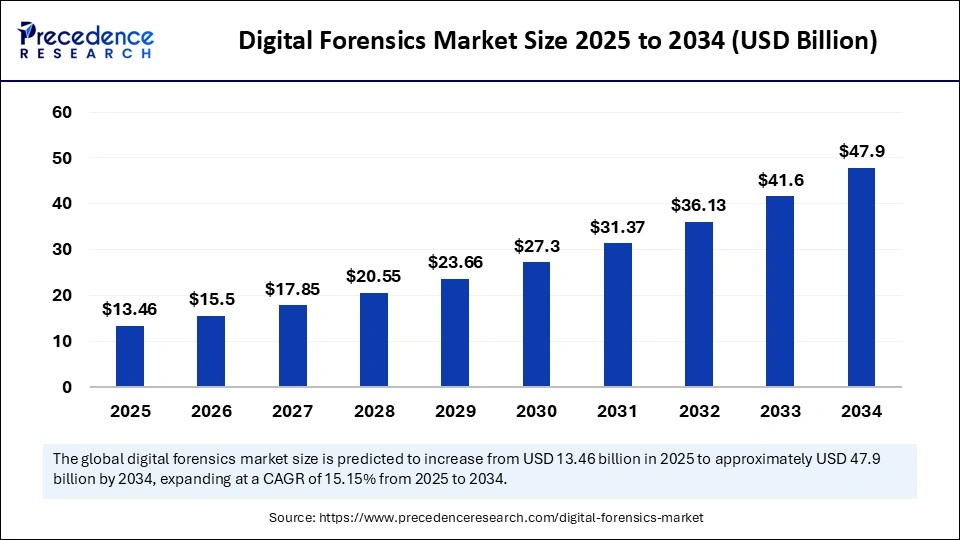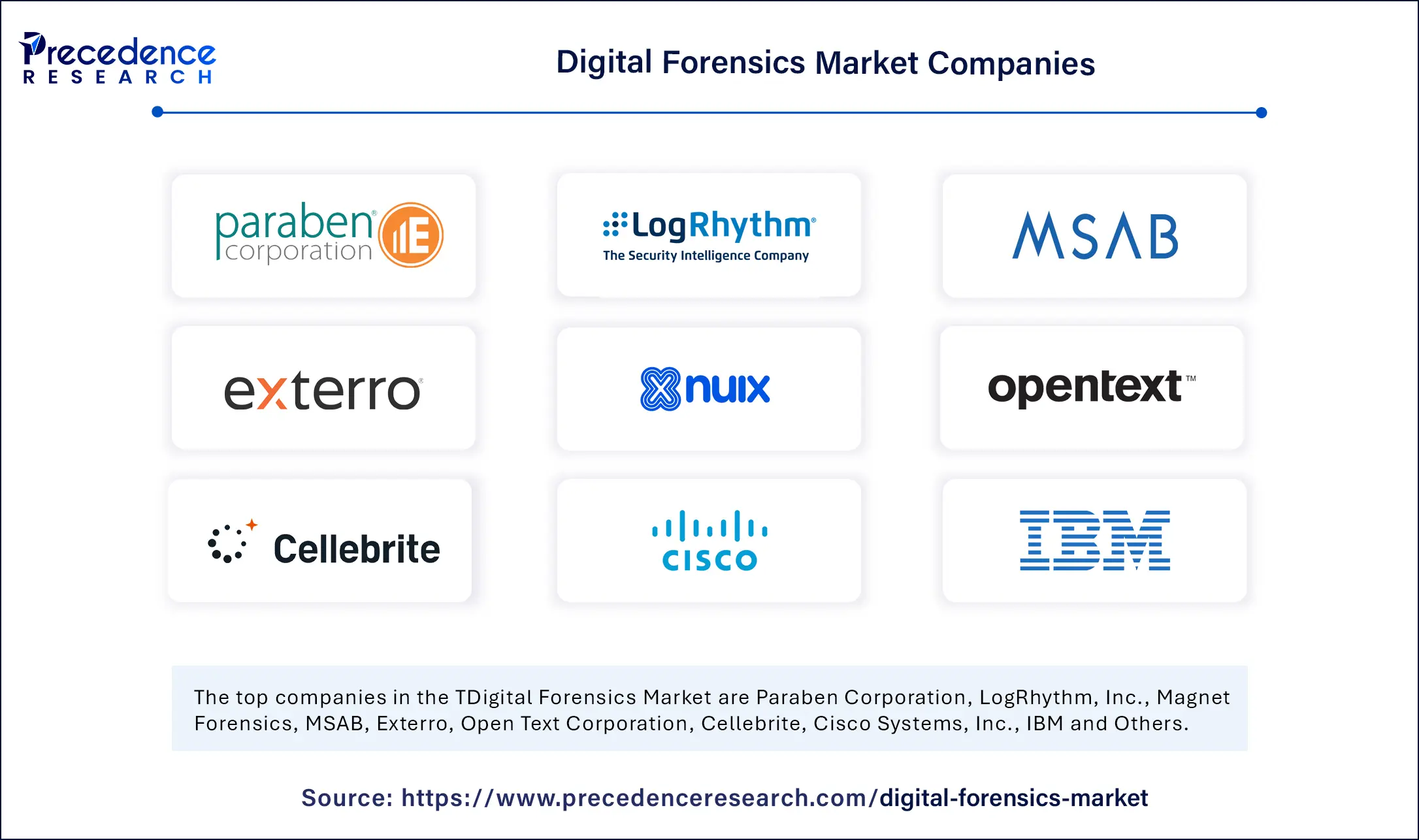
Digital Forensics Market Key Points
- North America led the global digital forensics market in 2024, accounting for the largest share of 37%.
- Asia Pacific is projected to grow at the fastest CAGR during the forecast period
- By component, the hardware segment held the largest market share of 43% in 2024.
- The service segment is expected to witness the highest CAGR between 2025 and 2034.
- By type, the computer forensics segment dominated the market in 2024.
- The cloud forensics segment is anticipated to grow at a significant CAGR over the forecast period.
- By tool, the forensic data analysis segment captured the highest market share in 2024.
- The forensic decryption tools segment is forecasted to expand at the fastest rate in the coming years.
- By end-user, the government and defense segment accounted for the largest share in 2024.
- The healthcare segment is expected to experience the fastest growth during the projection period.
Market Overview
The digital forensics market has become an essential pillar in modern cybersecurity, law enforcement, and corporate investigation landscapes. As the world becomes increasingly digitalized, the incidence and sophistication of cybercrimes have grown, necessitating advanced forensic capabilities to analyze, preserve, and present digital evidence in legal and investigative settings. Digital forensics refers to the process of identifying, collecting, examining, and analyzing data from digital devices—such as computers, smartphones, networks, and cloud systems—to uncover facts related to criminal or unauthorized activities.
Initially used mainly by law enforcement agencies, digital forensics has now expanded into private enterprises, government agencies, financial institutions, and healthcare providers. This expansion is driven by the rise of cyberattacks, data breaches, insider threats, and regulatory requirements surrounding data protection. The growing complexity of digital environments—including the use of encrypted communication, cloud storage, IoT devices, and mobile platforms—has amplified the demand for robust and scalable forensic solutions. The market includes various segments such as computer forensics, mobile forensics, network forensics, cloud forensics, and forensic data analytics, and it is poised for significant growth in both developed and emerging economies.
Digital Forensics Market Growth Factors
Several fundamental growth drivers are fueling the rapid expansion of the digital forensics market. First and foremost is the increased volume and sophistication of cybercrimes, including ransomware attacks, phishing, identity theft, corporate espionage, and financial fraud. Organizations and governments alike are investing in digital forensic capabilities to respond effectively to incidents and ensure that perpetrators can be identified and prosecuted.
Another important growth factor is the widespread digital transformation across industries, which has expanded the attack surface and the variety of data sources that need protection. As businesses move their operations to the cloud, adopt hybrid work models, and leverage big data, the need to monitor and investigate complex digital environments grows exponentially.
Regulatory mandates such as the General Data Protection Regulation (GDPR), the California Consumer Privacy Act (CCPA), and industry-specific compliance standards like HIPAA and PCI DSS are also driving demand for digital forensic tools and services. These regulations require organizations to not only protect sensitive data but also to have the capability to investigate and report security incidents accurately and promptly.
Moreover, the rise in nation-state cyber threats and terrorism-related digital investigations is pushing government agencies to enhance their forensic infrastructure. The need for real-time forensic readiness and continuous incident response capabilities in national security and defense sectors is acting as a strong catalyst for market growth.
Impact of AI on the Digital Forensics Market
Artificial Intelligence (AI) is profoundly transforming the digital forensics market, ushering in a new era of speed, accuracy, and automation in evidence analysis. One of the most critical applications of AI in digital forensics is the automated identification and categorization of relevant data across massive and unstructured data sets. Traditional manual investigations often require weeks to analyze digital footprints, but AI algorithms can accelerate this process by detecting anomalies, patterns, and hidden connections within minutes.
AI-driven natural language processing (NLP) is also being used to analyze textual content from emails, chats, and documents, helping investigators identify suspicious communications and intent. Meanwhile, machine learning models can learn from historical cyber incidents to predict likely intrusion patterns, detect zero-day threats, and recommend optimal response actions. These intelligent systems improve decision-making and help prioritize high-risk indicators during digital investigations.
In cloud and mobile forensics, AI enables real-time log analysis, file reconstruction, and activity timeline generation, offering forensic investigators a clearer view of the sequence of events leading up to an incident. Moreover, image and video analysis powered by computer vision allows for faster identification of illicit content or evidence in surveillance footage and media files.
AI also plays a pivotal role in ensuring the integrity and admissibility of digital evidence by minimizing human error and providing transparent, explainable outputs that align with legal standards. As digital environments become more complex, the integration of AI is essential to scale forensic operations, especially in environments with limited human expertise or high-volume investigations.
Digital Forensics Market Scope
| Report Coverage | Details |
| Market Size by 2034 | USD 47.9 Billion |
| Market Size in 2025 | USD 13.46 Billion |
| Market Size in 2024 | USD 11.69 Billion |
| Market Growth Rate from 2025 to 2034 | CAGR of 15.15% |
| Dominating Region | North America |
| Fastest Growing Region | Asia Pacific |
| Base Year | 2024 |
| Forecast Period | 2025 to 2034 |
| Segments Covered | Component, Type, Tool, End Use, and Region |
| Regions Covered | North America, Europe, Asia-Pacific, Latin America, and Middle East & Africa |
Market Drivers
The key drivers shaping the digital forensics market include the proliferation of digital devices and the increasing dependence on data-driven operations. As endpoints multiply—ranging from personal laptops and smartphones to IoT sensors and connected cars—every digital touchpoint becomes a potential source of forensic evidence. This surge in device usage demands advanced tools that can extract, analyze, and correlate data from disparate sources.
Another major driver is the surge in ransomware and targeted cyberattacks, which often require rapid forensic intervention to understand the attack vector, assess data loss, and recover compromised systems. These events push organizations to build in-house forensic teams or outsource to specialized service providers.
The rise in remote and hybrid work models has led to a decentralized workforce, where data flows across unsecured networks, personal devices, and third-party cloud services. This shift increases vulnerability to cyber threats and makes forensic readiness a business imperative. Organizations are also driven by the need to preserve digital evidence for legal, HR, or compliance purposes, which requires secure and tamper-proof forensic capabilities.
Lastly, court-admissible digital evidence requirements and cross-border investigation needs are boosting demand for certified tools and standardized forensic methodologies. Whether in corporate litigation or criminal justice, digital forensics has become a core pillar in evidence validation and legal proceedings.
Opportunities
The digital forensics market presents a host of opportunities across sectors and technologies. One significant opportunity lies in the increasing demand for cloud forensics solutions, as more data is stored and processed in cloud platforms like AWS, Azure, and Google Cloud. Providers that offer scalable, cloud-native forensic tools with advanced analytics will gain a competitive edge.
There is also a growing opportunity in mobile forensics, especially in emerging economies where smartphones are the primary computing device. The ability to extract and analyze data from mobile apps, encrypted communication platforms, and device logs is vital in criminal investigations and cybersecurity incidents.
Managed digital forensics services represent another major growth area, particularly for SMEs and public-sector organizations that lack in-house capabilities. Outsourcing forensic readiness, incident response, and legal documentation can be cost-effective and scalable, creating room for service providers to expand their footprint.
Moreover, AI-integrated forensic platforms, blockchain-based evidence preservation, and automated compliance reporting are emerging innovation areas. Companies that invest in R&D to develop next-generation forensic solutions that combine AI, zero-trust principles, and regulatory automation will benefit from growing market demand.
Education and training also present opportunities, as the growing complexity of forensic tools necessitates specialized skill sets. Institutions offering certified courses in digital forensics, AI in cybersecurity, and evidence law will play a crucial role in workforce development.
Challenges
Despite its rapid growth, the digital forensics market faces several challenges. A key issue is the shortage of skilled forensic professionals who can operate sophisticated tools, interpret results, and present findings in legally sound formats. This talent gap can lead to delays in investigations and underutilization of advanced forensic capabilities.
Another pressing challenge is the rapid evolution of technology and encryption. Cybercriminals often use secure communication tools, anti-forensics techniques, and file obfuscation methods to evade detection, making it difficult for forensic teams to trace their actions. The growing use of end-to-end encryption in messaging apps, for example, poses significant hurdles in mobile forensics.
The fragmentation of forensic tools and data formats is also a barrier, as investigators must often stitch together multiple software solutions to analyze data from different sources. This complexity increases investigation time and the potential for errors or inconsistencies.
Privacy concerns and legal restrictions around data collection, especially in cross-border scenarios, add another layer of complexity. Organizations must navigate conflicting international laws, such as the U.S. CLOUD Act versus the EU’s GDPR, which can impact how and where digital evidence is accessed and stored.
Lastly, the high cost of digital forensic software, hardware, and certifications can limit adoption among small law enforcement units or developing regions, slowing the democratization of forensic capabilities.
Regional Outlook
North America leads the digital forensics market, driven by high levels of cybercrime, stringent data protection regulations, and widespread adoption of advanced technologies in law enforcement and enterprise IT. The U.S., in particular, has a strong ecosystem of cybersecurity firms, digital forensic service providers, and federal agencies that invest heavily in forensic research and development.
Europe follows closely, with robust legal frameworks like the GDPR driving forensic readiness among enterprises and government bodies. Countries such as the UK, Germany, and France have established digital crime units and forensic labs, while also fostering innovation in privacy-preserving forensic technologies.
Asia Pacific is the fastest-growing region, fueled by the rapid digitization of economies, increasing cyber threats, and government investments in cybersecurity infrastructure. Nations like China, India, South Korea, and Japan are modernizing their legal enforcement and IT security capabilities, creating strong demand for forensic tools tailored to cloud, mobile, and network investigations.
Latin America is emerging as a growing market, particularly in Brazil and Mexico, where cybercrime is on the rise and digital financial services are expanding. Regional investments in digital policing and financial fraud detection are expected to support market growth.
Middle East and Africa are steadily adopting digital forensic technologies, especially in sectors like national security, telecommunications, and oil & gas. Countries such as the UAE and South Africa are advancing their cybersecurity frameworks and offering incentives to develop forensic labs and local expertise.
Digital Forensics Market Companies

- Paraben Corporation
- LogRhythm, Inc.
- Magnet Forensics
- MSAB
- Exterro
- NUIX
- Open Text Corporation
- Cellebrite
- Cisco Systems, Inc.
- IBM
Segments Covered in the Report
By Component
- Hardware
- Software
- Service
By Type
- Computer Forensics
- Network Forensics
- Mobile Device Forensics
- Cloud Forensics
By Tool
- Data Acquisition & Preservation
- Forensic Data Analysis
- Data Recovery
- Review & Reporting
- Forensic Decryption
- Others
By End Use
- Government and Defense
- Law Enforcement
- Banking, Financial Services, and Insurance (BFSI)
- IT & Telecom
- Retail
- Healthcare
- Others
By Region
- North America
- Asia Pacific
- Europe
- Latin America
- MEA
Also Read: Cross Border E-commerce Market
Get this report to explore global market size, share, CAGR, and trends, featuring detailed segmental analysis and an insightful competitive landscape overview @ https://www.precedenceresearch.com/sample/6251
You can place an order or ask any questions, please feel free to contact at sales@precedenceresearch.com|+1 804 441 9344